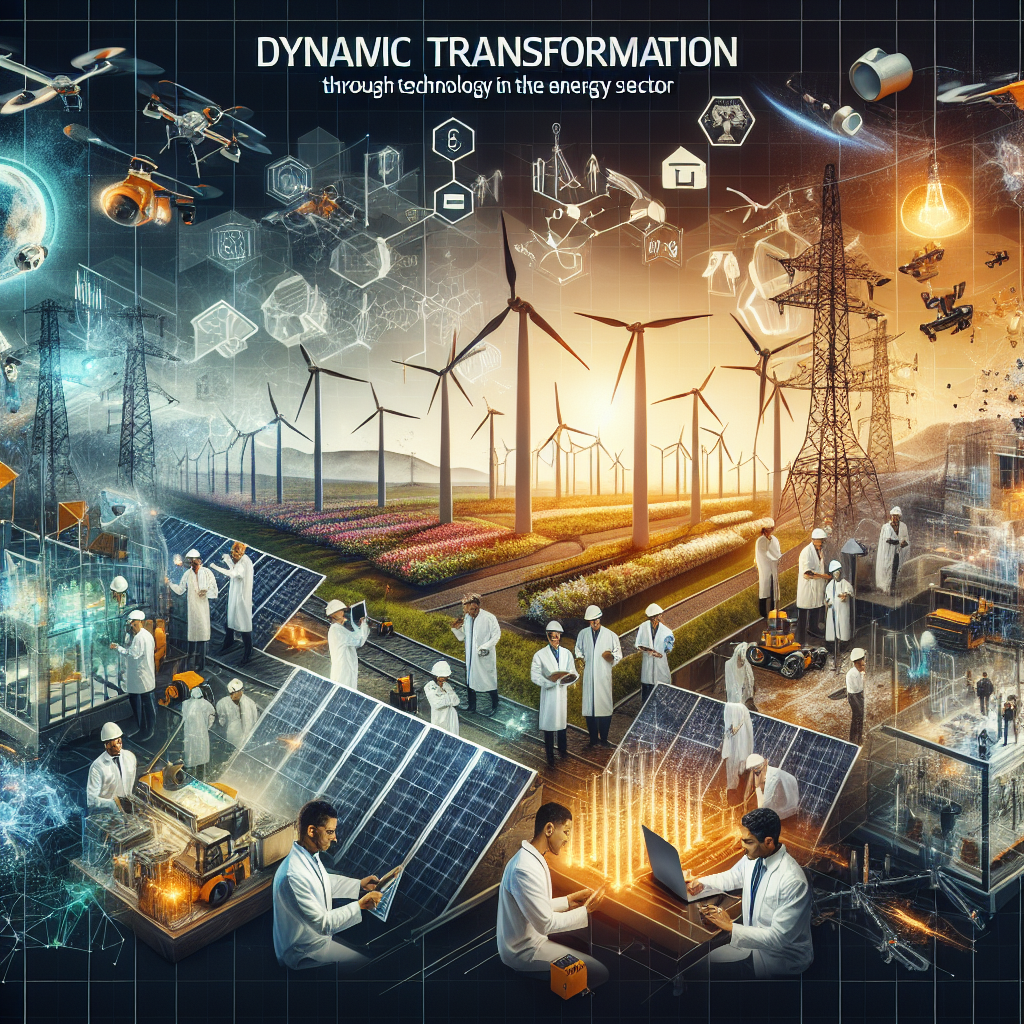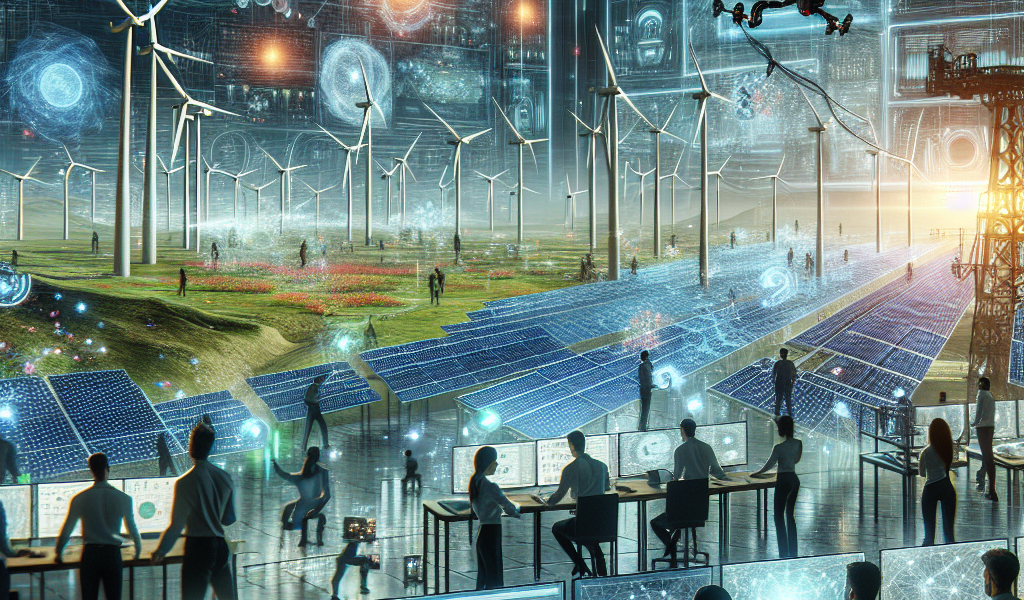-
Table of Contents
“Powering the Future: Revolutionizing Energy with Cutting-Edge Technology”
Introduction

The energy sector is undergoing a profound transformation driven by rapid advancements in technology. Innovations in renewable energy sources, smart grid systems, and energy storage solutions are revolutionizing how energy is produced, distributed, and consumed. The integration of artificial intelligence, the Internet of Things (IoT), and blockchain technology is enhancing efficiency, reliability, and sustainability across the industry. These technological advancements are not only reducing the carbon footprint but also paving the way for a more resilient and adaptive energy infrastructure. As the world grapples with the challenges of climate change and energy security, technology is playing a pivotal role in shaping a cleaner, smarter, and more sustainable energy future.
Smart Grids: Revolutionizing Energy Distribution
In recent years, the energy sector has undergone a significant transformation, largely driven by advancements in technology. One of the most groundbreaking developments in this field is the advent of smart grids, which are revolutionizing the way energy is distributed and consumed. Unlike traditional power grids, which rely on a one-way flow of electricity from power plants to consumers, smart grids utilize digital technology to create a two-way communication system. This allows for more efficient energy distribution, real-time monitoring, and greater integration of renewable energy sources.
The implementation of smart grids has brought about numerous benefits, starting with improved reliability and efficiency. Traditional power grids are often susceptible to outages and inefficiencies due to their outdated infrastructure. In contrast, smart grids employ advanced sensors and automated controls to detect and respond to issues in real-time. This means that potential problems can be identified and addressed before they escalate into major disruptions, thereby ensuring a more stable and reliable energy supply.
Moreover, smart grids facilitate better energy management by providing consumers with detailed information about their energy usage. Through smart meters and connected devices, households and businesses can monitor their consumption patterns and make informed decisions to reduce their energy bills. This not only empowers consumers but also contributes to overall energy conservation. For instance, during peak demand periods, smart grids can send signals to smart appliances to reduce their energy consumption, thereby alleviating strain on the grid and preventing blackouts.
Another significant advantage of smart grids is their ability to integrate renewable energy sources more effectively. Traditional grids are often ill-equipped to handle the intermittent nature of renewable energy, such as solar and wind power. However, smart grids can dynamically adjust to fluctuations in energy supply and demand, making it easier to incorporate these sustainable sources into the energy mix. This is crucial for reducing our reliance on fossil fuels and mitigating the impacts of climate change.
Furthermore, the data collected by smart grids can be leveraged to optimize energy distribution on a larger scale. By analyzing consumption patterns and predicting future demand, utility companies can make more informed decisions about where to allocate resources. This not only enhances operational efficiency but also reduces costs, which can be passed on to consumers in the form of lower energy prices.
Despite these benefits, the transition to smart grids is not without its challenges. One of the primary concerns is cybersecurity. As smart grids rely heavily on digital communication and data exchange, they are vulnerable to cyberattacks. Ensuring the security and privacy of this data is paramount to maintaining consumer trust and safeguarding the grid’s integrity. Additionally, the initial investment required to upgrade existing infrastructure can be substantial. However, many experts argue that the long-term benefits far outweigh the initial costs, making it a worthwhile investment for the future.
In conclusion, smart grids represent a significant leap forward in the evolution of the energy sector. By enhancing reliability, promoting energy efficiency, and facilitating the integration of renewable sources, they are paving the way for a more sustainable and resilient energy system. While challenges remain, the potential benefits of smart grids are too significant to ignore. As technology continues to advance, it is likely that we will see even more innovative solutions that will further transform the way we produce, distribute, and consume energy.
Renewable Energy Innovations: Harnessing the Power of Nature
In recent years, the energy sector has undergone a remarkable transformation, driven by technological advancements that are reshaping how we harness and utilize power. Renewable energy innovations, in particular, are at the forefront of this revolution, offering sustainable solutions that tap into the natural forces around us. As the world grapples with the pressing need to reduce carbon emissions and combat climate change, these cutting-edge technologies are proving to be game-changers.
One of the most significant developments in renewable energy is the evolution of solar power. Solar panels have become more efficient and affordable, making it easier for both individuals and businesses to adopt this clean energy source. Advances in photovoltaic technology have led to the creation of solar cells that can capture more sunlight and convert it into electricity with greater efficiency. Moreover, innovations such as solar tracking systems, which adjust the angle of panels to follow the sun’s path, have further enhanced the energy output. As a result, solar power is becoming an increasingly viable option for meeting our energy needs.
Wind energy is another area where technology is making a substantial impact. Modern wind turbines are now capable of generating more power than ever before, thanks to improvements in design and materials. For instance, the development of larger and more aerodynamic blades has allowed turbines to capture more wind energy, even at lower wind speeds. Additionally, offshore wind farms are gaining traction, as they can harness the stronger and more consistent winds found over the ocean. These advancements are helping to make wind power a more reliable and significant contributor to the global energy mix.
Transitioning from traditional energy sources to renewables also involves overcoming challenges related to energy storage and distribution. Here, technology is playing a crucial role as well. Battery storage systems have seen remarkable progress, with innovations in lithium-ion and other advanced battery technologies enabling the storage of excess energy generated by renewable sources. This stored energy can then be used during periods when the sun isn’t shining or the wind isn’t blowing, ensuring a steady and reliable power supply. Furthermore, smart grid technology is revolutionizing the way energy is distributed and managed. By using sensors and advanced analytics, smart grids can optimize the flow of electricity, reduce waste, and enhance the overall efficiency of the energy system.
In addition to solar and wind, other renewable energy sources are benefiting from technological advancements. For example, geothermal energy, which taps into the Earth’s internal heat, is becoming more accessible and efficient through innovations in drilling techniques and heat exchange systems. Similarly, advancements in bioenergy, which involves converting organic materials into fuel, are making it a more sustainable and scalable option. These diverse renewable energy sources, supported by cutting-edge technology, are collectively contributing to a more resilient and sustainable energy landscape.
As we look to the future, the continued integration of technology into the renewable energy sector holds immense promise. Research and development efforts are ongoing, with scientists and engineers exploring new materials, designs, and methods to further enhance the efficiency and affordability of renewable energy solutions. The collaboration between governments, private companies, and research institutions is also crucial in driving these innovations forward.
In conclusion, the transformative power of technology is evident in the rapid advancements being made in the renewable energy sector. By harnessing the power of nature through innovative solutions, we are not only addressing the urgent need for sustainable energy but also paving the way for a cleaner and more prosperous future. As these technologies continue to evolve, they will undoubtedly play a pivotal role in shaping the energy landscape for generations to come.
AI and Machine Learning: Optimizing Energy Efficiency
Artificial Intelligence (AI) and Machine Learning (ML) are revolutionizing various industries, and the energy sector is no exception. These advanced technologies are playing a pivotal role in optimizing energy efficiency, thereby contributing to a more sustainable future. As the world grapples with the challenges of climate change and the need for cleaner energy sources, AI and ML offer promising solutions that can significantly enhance the way we produce, distribute, and consume energy.
To begin with, AI and ML are being utilized to improve the efficiency of energy production. Traditional energy systems often rely on outdated methods that are not only inefficient but also environmentally harmful. However, AI algorithms can analyze vast amounts of data to identify patterns and predict outcomes, enabling energy producers to optimize their operations. For instance, in the realm of renewable energy, AI can forecast weather conditions with remarkable accuracy, allowing solar and wind farms to maximize their energy output. By predicting periods of high and low energy production, these technologies help in better planning and storage, ensuring a steady supply of energy.
Moreover, AI and ML are transforming the way energy is distributed. The traditional grid system is often plagued by inefficiencies and vulnerabilities, leading to energy losses and blackouts. Smart grids, powered by AI, are capable of self-regulating and adapting to changing conditions in real-time. These grids can detect faults, reroute power, and even predict maintenance needs, thereby reducing downtime and improving reliability. Additionally, AI-driven demand response systems can adjust energy consumption patterns based on real-time data, ensuring that energy is used more efficiently and reducing the strain on the grid during peak times.
Transitioning from production and distribution, AI and ML are also making significant strides in energy consumption. Smart meters and home automation systems, equipped with AI, provide consumers with detailed insights into their energy usage. These systems can suggest ways to reduce consumption, such as adjusting thermostat settings or turning off unused appliances. Furthermore, AI can learn from user behavior and automatically implement energy-saving measures, making it easier for individuals to contribute to energy efficiency without sacrificing comfort.
In the industrial sector, AI and ML are being used to optimize energy usage in manufacturing processes. Factories equipped with AI-driven systems can monitor energy consumption in real-time and make adjustments to minimize waste. For example, AI can optimize the operation of machinery, ensuring that it runs at peak efficiency and only when necessary. This not only reduces energy costs but also extends the lifespan of the equipment, leading to further savings.
Another exciting development is the integration of AI and ML in electric vehicles (EVs) and their charging infrastructure. AI can optimize charging schedules based on grid demand and energy prices, making EVs more cost-effective and reducing their impact on the grid. Additionally, AI can enhance battery management systems, improving the efficiency and lifespan of EV batteries.
In conclusion, AI and ML are proving to be game-changers in the energy sector. By optimizing energy production, distribution, and consumption, these technologies are paving the way for a more efficient and sustainable energy future. As we continue to innovate and integrate AI and ML into our energy systems, we can look forward to a world where energy is not only more accessible but also more environmentally friendly. The potential of these technologies is immense, and their continued development will undoubtedly play a crucial role in addressing the global energy challenges we face today.
Conclusion
Technology is revolutionizing the energy sector by enhancing efficiency, reducing costs, and promoting sustainability. Innovations such as smart grids, renewable energy sources, and energy storage systems are enabling more reliable and cleaner energy production and distribution. Advanced data analytics and IoT devices are optimizing energy consumption and management, while blockchain technology is improving transparency and security in energy transactions. Overall, these technological advancements are driving the transition towards a more sustainable and resilient energy future.





